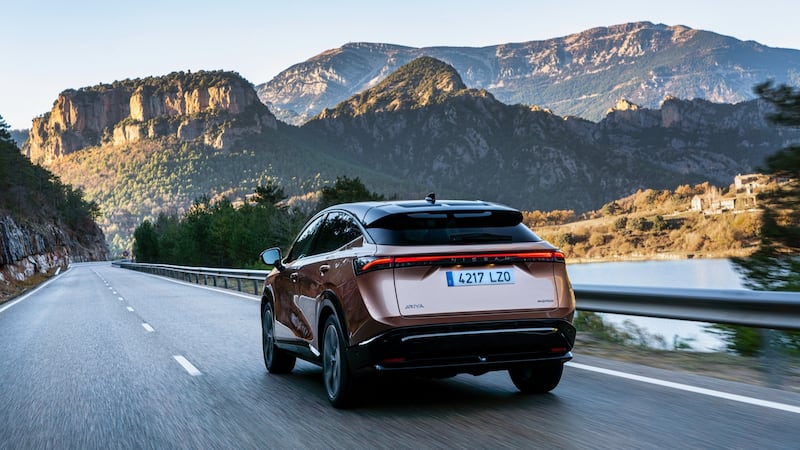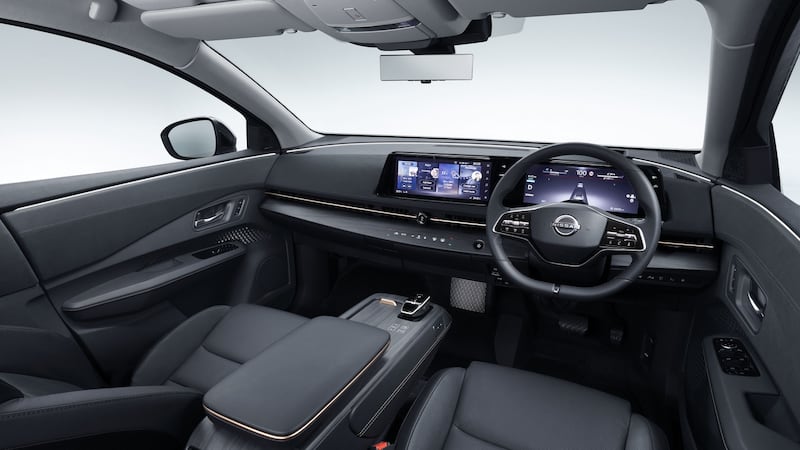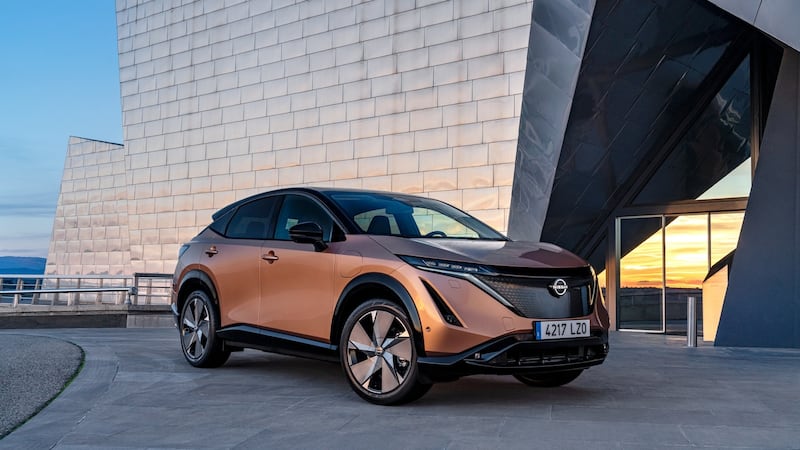The fully electric Nissan Ariya will land in Ireland mid-summer after a gestation period that would shame an African elephant.
The striking looking EV forms a key part of a new six-vehicle line-up that spearheads Nissan's next chapter in EV motoring. Nissan says it will not introduce any non-hybrid or electric cars in Europe from 2023. So as the internal combustion engine sings its swansong at Nissan to a dwindling crowd, a new aria looks set to electrify audiences.
We put a pre-production version of the much-hyped five-seat Ariya SUV through its paces on a test track in Madrid. The Ariya is built on the new CMF-EV platform shared with alliance partner Renault. It will be available with either a 63kWh or 87kWh battery (net) and weighs in between 1.8 and 2.3 tonnes. Nissan claims a driving range of up to 360km and 500km respectfully from a full charge.
The standard car features a front wheel drive set up powered by a single motor. A 87kWh dual motor “e-4orce” all-wheel drive version will also feature in the line-up with a maximum range of about 460km.
While it may sound like the name for an eco-friendly security company, the e-4orce system is innovative and impressive. Our test Ariya’s were single motor 63s, but we were able to test the e-4orce system in a Nissan Leaf mule. As you’d expect its clever electronics allow the inner wheels to be braked to aid cornering – nothing new there – but it is the system’s ability to overcome a car’s natural urge to pitch and wallow in bends that suggests Nissan will have an edge on the road over rivals.

The Ariya is a halo model for the Japanese brand and while it shares a common scalable platform with Renault’s new electric Megane, the Japanese car brand has gone its own route with Ariya to make a much larger, more imposing car.
The Ariya’s crossover styling disguises the fact it is substantially larger than the ubiquitous Nissan Qashqai. Its front end is striking with an illuminated Nissan badge taking centre stage. Flush, aerodynamic surfacing combine well with technical looking lights and a nicely sculpted clamshell bonnet. In profile, its 20in wheels fill out the arches well (19s are standard).
The cabin features oodles of space, premium materials, and of course high-tech displays (two 12.3in screens). Dash and centre console surfaces feature flush haptic buttons and switchgear similar to the latest used by BMW in its iX EV. The new compact auto gear selector almost seems lost on the centre console.
The rear is spacious with easy access due to its flat floor. Visibility is good in the back and the boot is a good size too with 446 litres (FWD) and 408 litres with the second motor fitted. The boot features a Qashqai-like split floor and floor dividers that are so useful for the complex loads a family car's boot must carry. Connectivity is cutting edge with Google and Amazon integration.

On the test track we used all three of its driving modes and performed high, medium and low speed manoeuvres. The Ariya has ample acceleration, and its ride quality is near flawless, but then again, we were on a smooth racetrack. Direction changes were made with confidence as its steering ratio is tuned for a dynamic and sporty drive. A little steering input delivers a direct and satisfying result.
Impressive traction
On the day of testing, Madrid was coated with fine red Sharan dust. The high-grip track surface was compromised, and this was a good thing as the dusty layer made the Ariya’s ability to find traction and grip when cornering all the more impressive. At extremes of adhesion, we could always feel what was going on at the four points of contact with the road. Very little harshness is transmitted through the accelerator or steering wheel. Unfortunately, the track was devoid of potholes or damaged tarmac to test and unsettle the suspension, but all the signs imply the Ariya will be able to handle them.
Acceleration is, as you’d expect, brisk. Power outputs range from 214hp/300nm (single motor) to 239hp/600nm for the dual motor. These deliver 0-100km times as brisk as 5.7 seconds with 7.5 seconds the entry model’s time.

Nissan is confident its next generation EV will be efficient. Those potential buyers rightly concerned about access to public charging should note a 22kW on board charger is an option (possibly standard in Ireland) and this facilitates faster charging at public “slow” chargers (the ones where you use your own cable) compared to rivals.
The Ariya can quick charge at speeds up to 130kW using its CCS (AC/DC) charge port, so a 10 to 80 per cent charge takes about 35 minutes on the 63kWh version or 40minutes for the larger battery version.
Pricing and the grade structure for Ariya in Ireland are not yet finalised, but as with all new electric cars coming to our shores demand will undoubtedly exceed supply.
A myriad of assistance systems and electronic driving aids are available like ProPilot, emergency lane keeping, traffic sign recognition, adaptive lights, intelligent emergency braking, connected services with over the air updates.
Over the last decade Nissan has sold more than 570,000 Leaf EVs, and claims its EVs have accomplished 9.8 billion kms in that time. A much-need addition to its EV range is now set to arrive, and first impressions suggest the Ariya is a confident step forward by the brand.









